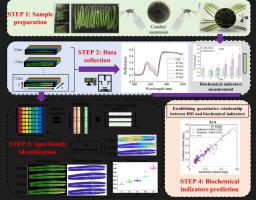Engineering ( IF 10.1 ) Pub Date : 2022-11-28 , DOI: 10.1016/j.eng.2022.10.006 Fengle Zhu , Zhenzhu Su , Alireza Sanaeifar , Anand Babu Perumala , Mostafa Gouda , Ruiqing Zhou , Xiaoli Li , Yong He

|
Plant pathogens continuously impair agricultural yields and food security. Therefore, the dynamic characterization of early pathogen progression is crucial for disease monitoring and presymptomatic diagnosis. Hyperspectral imaging (HSI) has great potential for tracking the dynamics of initial infected sites for presymptomatic diagnosis; however, no related studies have extracted fingerprint spectral signatures (FSSs) that can capture diseased lesions on leaves during the early infection stage in vivo or investigated the detection mechanism of HSI relating to the host biochemical responses. The FSSs denote unique and representative spectral signatures that characterize a specific plant disease. In this study, the FSSs of spot blotch on barley leaves inoculated with Bipolaris sorokiniana were discovered to characterize symptom development for presymptomatic diagnosis based on time-series HSI data analysis. The early spectral and biochemical responses of barley leaves to spot blotch progression were also investigated. The full-spectrum FSSs were physically interpretable and could capture the unique characteristics of chlorotic and necrotic tissues along with lesion progression, enabling the in situ visualization of the spatiotemporal dynamics of early plant–pathogen interactions at the pixel level. Presymptomatic diagnosis of spot blotch was achieved 24 h after inoculation—12 h earlier than the traditional polymerase chain reaction (PCR) assay or biochemical measurements. To uncover the mechanism of HSI presymptomatic diagnosis, quantitative relationships between the mean spectral responses of leaves and their biochemical indicators (chlorophylls, carotenoids, malondialdehyde (MDA), ascorbic acid (AsA), and reduced glutathione (GSH)) were developed, achieving determination coefficient of prediction set (Rp2) > 0.84 for regression models. The overall results demonstrated that, based on the association between HSI and in vivo plant-trait alterations, the extracted FSSs successfully tracked the spatiotemporal dynamics of bipolaris spot blotch progression for presymptomatic diagnosis. Tests of this methodology on other plant diseases demonstrated its remarkable generalization potential for the early control of plant diseases.
中文翻译:

指纹光谱特征揭示双极斑点斑病进展的时空动态,用于症状前诊断
植物病原体不断损害农业产量和粮食安全。因此,早期病原体进展的动态表征对于疾病监测和症状前诊断至关重要。高光谱成像 (HSI) 在跟踪初始感染部位的动态以进行症状前诊断方面具有巨大潜力;然而,没有相关研究提取可以在体内早期感染阶段捕获叶片病斑的指纹光谱特征(FSS)或研究与宿主生化反应相关的HSI检测机制。FSS 表示表征特定植物病害的独特且具有代表性的光谱特征。在这项研究中,大麦叶片上斑斑病的 FSSs 接种了Bipolaris sorokiniana被发现用于表征基于时间序列 HSI 数据分析的症状前诊断的症状发展。还研究了大麦叶片对斑斑病进展的早期光谱和生化反应。全光谱 FSS 具有物理可解释性,可以捕获褪绿和坏死组织的独特特征以及病变进展,从而实现原位在像素级别可视化早期植物-病原体相互作用的时空动态。接种后 24 小时可对斑点斑点进行症状前诊断——比传统的聚合酶链反应 (PCR) 测定或生化测量早 12 小时。为了揭示 HSI 症状前诊断的机制,开发了叶片的平均光谱响应与其生化指标(叶绿素、类胡萝卜素、丙二醛 (MDA)、抗坏血酸 (AsA) 和还原型谷胱甘肽 (GSH))之间的定量关系,实现了测定回归模型的预测集系数 ( R p 2 ) > 0.84。总体结果表明,基于 HSI 与体内植物性状改变,提取的 FSS 成功地追踪了双极斑点斑病进展的时空动态,用于症状前诊断。该方法对其他植物病害的测试证明了其在植物病害早期控制方面的显着推广潜力。











































 京公网安备 11010802027423号
京公网安备 11010802027423号